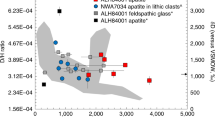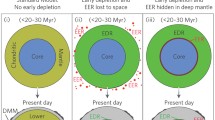Abstract
The high FeO concentrations measured by VIKING for the Martian soils correspond to all probability to a FeO-rich mantle. In general, the VIKING XRF-data indicate a mafic crust with a considerably smaller degree of fractionation compared to the terrestrial crust.
In recent years evidence has been collected which points towards Mars being the parent body of SNC-meteorites and, hence, these meteorites have become a valuable source of information about the chemistry of Mars. Using element correlations observed in SNC-meteorites and general cosmochemical constraints, it is possible to estimated the bulk composition of Mars. Normalized to Si and Cl, the mean abundance value for the elements Ga, Fe, Na, P, K, F, and Rb in the Martian mantle is found to be 0.35 and thus exceeds the terrestrial value by about a factor of two. Aside pressure effects and the H2O poverty, the high P and K content of the Martian mantle may lead to magmatic processes different from those on Earth.
The composition of the Earth's mantle can successfully be described by a two component model. Component A: highly reduced and almost free of all elements more volatile than Na; component B: oxidized and containing all elements in Cl-abundances including volatile elements. The same two components can be used as building blocks for Mars, if one assumes that, contrary to the inhomogeneous accretion of the Earth, Mars accreted almost homogeneously. The striking depletion of all elements with chalcophile character indicates that chemical equilibrium between component A and B was achieved on Mars which lead to the formation of significant amounts of FeS which, on segregation, extracted the elements according to their sulphide-silicate partition coefficients. While for the Earth a mixing ratio A∶B = 85∶15 was derived, the Mars ratio of 60∶40 reflects the higher concentrations of moderately volatile elements like Na, K, and sulphur on Mars. A homogeneous accretion of Mars could also explain the obvious low abundances of water and primordial rare gases.
Similar content being viewed by others
References
Clark, B.C., Baird, A.K., Weldon, R.J., Tsusaki, D.M., Schnabel, L., and Candelaria, M.P.: 1982, J. Geophys. Res. 87, 10059–10067.
Anders E. and Owen, T. 1977 Science 198, 453–465.
Lundin, R., Zakharov, A., Pellinen, R., Borg, H., Hultqvist, B., Pissarenko, N., Dubinin, E.M., Barabash, S.W., Liede, I., and Koskinen, H.: 1989, Nature 341, 609–612.
Rosenbauer, H., Shutte, N., Apáthy, I., Galeev, A., Gringauz, K., Grünwaldt, H., Hemmerich, P., Jockers, K., Király, P., Kotova, G., Livi, S., Marsch, E., Richter, A., Riedler, W., Remizov, T., Schwenn, R., Schwingenschuh, K., Steller, M., Szegö, K., Verigin, M., and Witte, M.: 1989, Nature 341, 612–614.
Jagoutz, E.: 1989, Geochim. Cosmochim. Acta 53, 2429–2441.
Wasson J. T. and Wetherill, G.W.: 1989, in T. Gehrels (ed.) Asteroids, University Arizona Press, Tucson, pp. 926–974.
Bogard D.D. and Johnson, P.: 1983 Science 221, 651–654.
Becker R.H. and Pepin, R.O.: 1984, Earth Planet. Sci. Lett. 69, 225–242.
Pepin, R.O.: 1985, Nature 317, 473–475.
McSween, Jr. H.Y. and Stolper, E.M.: 1980 Scientific American 242, 44–53.
Dreibus G. and Wänke, H.: 1984, in Proc. 27th Intern. Geol. Con, Vol. 11, VNU Science Press, pp. 1–20.
Wänke H. and Dreibus, G.: 1988, Phil. Trans. R. Soc. Lond. A 325, 545–557.
Yang J. and Epstein, S.: 1985, Lunar Planet. Science XVI, Lunar and Planetary Institute, Houston, pp. 25–26.
Dreibus G. and Wänke, H.: 1987, Icarus 71, 225–240.
Dreibus G. and Wänke, H.: 1989, in S.K. Atreya, J.B. Pollack and M.S. Matthews (eds.) Origin and Evolution of Planetary and Satellite Atmospheres Univ. Arizona Press pp. 268–288.
Wood, J.A.: 1962, Nature 194, 127–130.
Anders, E.: 1964, Space Sci. Rev. 3, 583–714.
Larimer J.W. and Anders, E.: 1967, Geochim. Cosmochim. Acta 31, 1239–1270.
Ringwood, A.E.: 1977, Geochem. J. 11, 111–135.
Ringwood, A.E.: 1979, On the Origin of the Earth and Moon, Springer-Verlag, New York 1979.
Wänke, H.: 1981, Phil. Trans. R. Soc. Lond. A 303, 287–302.
Jagoutz, E., Palme, H., Baddenhausen, H., Blum, K., Cendales, M., Dreibus, G., Spettel, B., Lorenz, V., and Wanke, H.: 1979, Proc. Lunar Planet. Sci. Conf. 10th, 2031–2050.
Author information
Authors and Affiliations
Rights and permissions
About this article
Cite this article
Wänke, H. Chemistry, accretion, and evolution of Mars. Space Sci Rev 56, 1–8 (1991). https://doi.org/10.1007/BF00178384
Received:
Issue Date:
DOI: https://doi.org/10.1007/BF00178384




